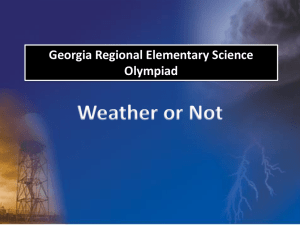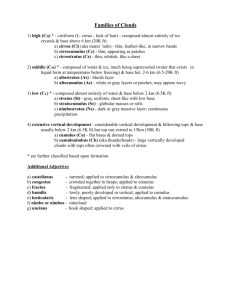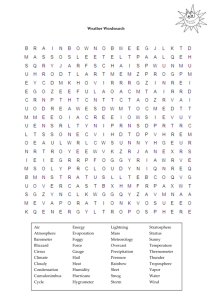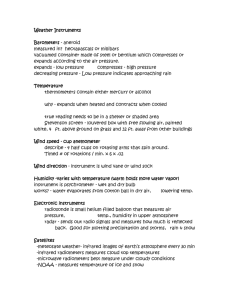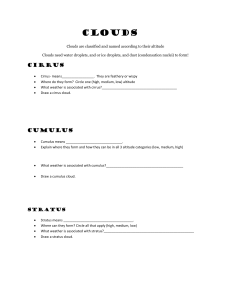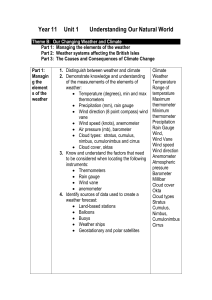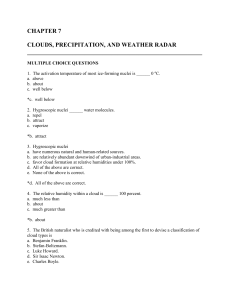Cloud
advertisement
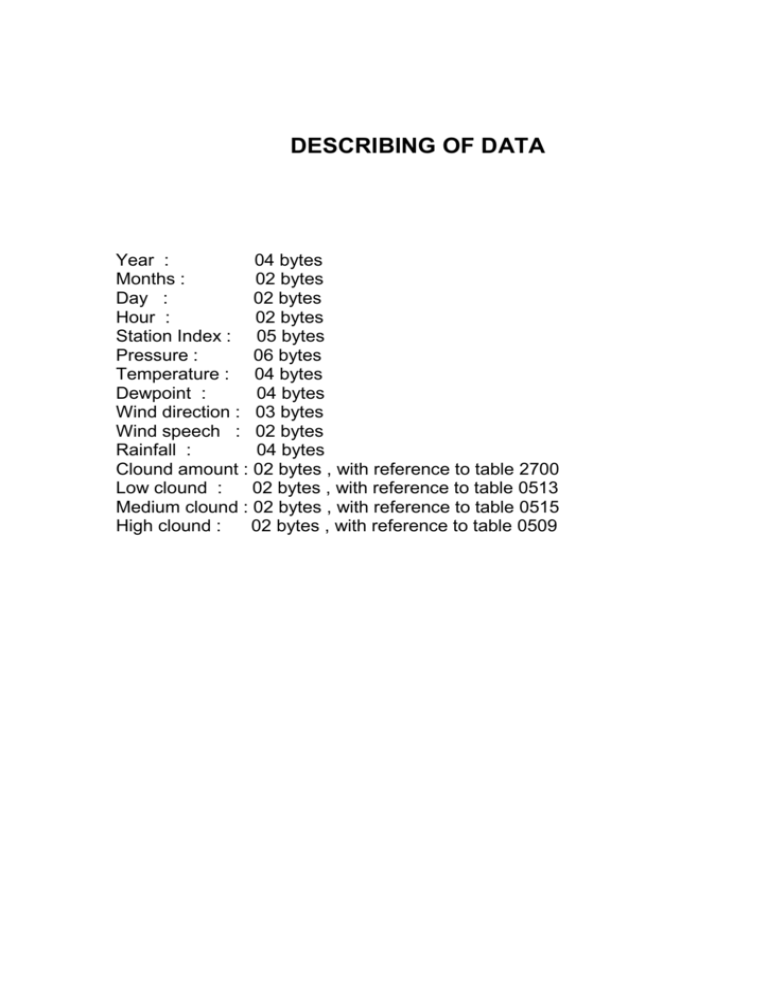
DESCRIBING OF DATA Year : 04 bytes Months : 02 bytes Day : 02 bytes Hour : 02 bytes Station Index : 05 bytes Pressure : 06 bytes Temperature : 04 bytes Dewpoint : 04 bytes Wind direction : 03 bytes Wind speech : 02 bytes Rainfall : 04 bytes Clound amount : 02 bytes , with reference to table 2700 Low clound : 02 bytes , with reference to table 0513 Medium clound : 02 bytes , with reference to table 0515 High clound : 02 bytes , with reference to table 0509 CODE TABLE 2700 N : Clound amount Nh : The amound of clound CL or the amount of clound CM when NS : The amount of clound bank or clound zone when having only C Code 0 1 2 3 4 5 6 7 8 9 / Remard : Technical specification No clound 1/10 or less ,but should have clound 2/10 to 3/10 4/10 5/10 6/10 7/10 to 8/10 9/10 or more ,but not cover all 10/10 Dark as frost or other atmospheric phenomena No clound observation as other reason N = / only using at automatic station CH Code tables 0509 Clouds of the genera Cirrus, Cirrocumulus and Cirrostratus Code figure Technical specifications Code figure CH Non - technical specifications 0 No CH clouds 0 No Cirrus (Ci), or cirrostratus (Cs) 1 Cirrus fibratus, sometimes uncinus, not progressively invading the sky Cirrus spissatus, in patches or entangled sheaves, which usually do not increase and sometimes seem to be the remains of the upper part of a Cumulonimbus; or Cirrus castellanus or floccus 1 3 Cirrus spissatus cumulonimbogenitus 3 4 Cirrus uncinus or fibratus, or both, progressively invading the sky; they generally thicken as a whole 4 5 Cirrus (often in bands) and Cirrostratus, or Cirrostratus alone, progressively invading the sky; they generally thicken as a whole, but the continuous veil does not reach 45 degrees above the horizon 5 6 Cirrus (often in bands) and Cirrostratus, or Cirrostratus alone, progressively invading the sky; they generally thicken as a whole; the continuous veil extends more than 45 degrees above the horizon, without the sky being totally covered 6 7 Cirrostratus covering the whole sky 7 8 Cirrostratus not progressively invading the sky, and not entirely covering it 8 9 Cirrocumulus alone, or Cirrocumulus predominant among the CH clouds 9 / CH Clouds invisible owing to darkness, fog, blowing dust or sand, or other similar phenomena,or because of a continuous layer of lower clouds / Cirrus (Ci) in the form of filaments, strands or hooks, not progressively invading the sky Dense Cirrus (Ci), in patches or entangled sheaves, which usually do not increase and sometimes seem to be the remains of the upper part of a Cumulonimbus (Cb); or Cirrus (Ci) with sproutings in the form of small turrets or battlements, or Cirrus (C i) having the appearance of cumuliform tufts Dense Cirrus(Ci), often in the form of an anvil, being the remains of the upper part of a Cumulonimbus (Cb) Cirrus (Ci) in the form of hooks or of filaments, or both, progressively invading the sky; they generally become denser as a whole Cirrus (Ci) (often in bands converging towards one point or two opposite points of the horizon) and Cirrostratus (Cs), or Cirrostratus (Cs) alone; in either case, they are progressively invading the sky, and generally growing denser as a whole, but the continuous veil does not reach 45 degrees above the horizon Cirrus(Ci) (often in bands converging towards one point or two opposite points of the horizon) and Cirrostratus (Cs), or Cirrostratus (Cs) alone; in either case they are progressively invading the sky, and generally growing denser as a whole, the continuous veil extends more than 45 degrees above the horizon, without the sky being totally covered Veil of Cirrostratus (Cs) covering the celestial dome Cirrostratus (Cs) not progressively invading the sky and not completely covering the the celestial dome Cirrocumulus (Cc) alone, or Cirrocumulus (Cc) accompanied by Cirrus (Ci), or Cirrostratus (Cs) or both, but Cirrocumulus (Cc)is predominant Cirrus (Ci), Cirrocumulus (Cc) and Cirrostratus (Cs) invisible owing to darkness, fog, blowing dust or sand, or other similar phenomena, or more often because of the presence of a continuous layer of lower clouds 2 2 Code tables 0513 CL Clouds of the genera Stratocumulus, Stratus, Cumulus and Cumulonimbus Code figure Technical specifications Code figure 0 No CL clouds 0 1 Cumulus humilis or Cumulus fractus other than of bad weather*, or both 1 2 Cumulus mediocris or congestus with or without Cumulus of species fractus or humilis or Stratocumulus, all having their bases at the same level 2 3 Cumulonimbus calvus, with or without Cumulus, Stracumulus or Stratus 3 4 Stracumulus cumulogentitus 4 5 Stracumulus other than Stracumulus cumulogentitus Stratus nebulosus or Stratus fractus other than of bad weather*, or both 5 7 Stratus fractus or Cumulus fractus of bad weather* , or both (pannus), usually below Altostratus or Nimbostratus 7 8 Cumulus and Stratocumulus other than Stratocumulus cumulogenitus, with bases at different levels 8 9 Cumulonimbus capillatus (often with an anvil), with or without Cumulonimbus calvus, Cumulus, Stratocumulus Stratus or pannus 9 / CL Clouds invisible owing to darkness, fog, blowing dust or sand, or other similar phenomena / 6 6 Non - technical specifications No Stratocumulus (Sc), Stratus (St), and Cumulonimbus (Cb) Cumulus (Cu) with little vertical extent and seemingly flatened, or ragged Cumulus (Cu) other than of bad weather*, or both Cumulus (Cu) of moderate or strong vertical extent, generally with protuberances in the form of domes or towers, either accompanied or not by other Cumulus (Cu) or by Stracumulus (Sc) all having their bases at the same level Cumulonimbus (Cb) the summits of which, at least partially, lack sharp outlines but are neither clearly fibrous (cirriform) nor in the form of an anvil; Cumulus (Cu), Stracumulus (Sc) or Stratus (St) may also be present Stracumulus (Sc) formed by the spreading out of Cumulus (Cu), Cumulus (Cu), may also be present Stracumulus (Sc) not resulting from the spreading out of Cumulus (Cu) Stratus (St) in a more or less continuous sheet or layer, or in ragged shreds, or both but no Stratus (St) fractus of bad weather* Stratus (St) fractus of bad weather* or Cumulus (Cu) fractus of bad weather* , or both (pannus), usually below Altostratus (As) or Nimbostratus (Ns) Cumulus (Cu) and Stratocumulus (Sc) other than that formed from the spreading out of Cumulus (Cu); the base of the Cumulus is at a different level from that of the Stratocumulus (Sc) Cumulonimbus (Cb), the upper part of which is clearly fibrous (cirriform), often in the form of an anvil; either accompanied or not by Cumulonimbus (Cb) without anvil or fibrous upper part, Cumulus (Cu), Stratocumulus (Sc) Stratus (St) or pannus Stratocumulus (Sc) Stratus (St) Cumulus (Cu) and Cumulonimbus (Cb) invisible owing to darkness, fog, blowing dust or sand, or other similar phenomena * “Bad weather “ denotes the conditions which generally exist during precipitation and a short time before and after Code tables 0515 CM CM Clouds of the genera Altocumulus, Altostratus and Nimbostratus Code figure Technical specifications Code figure 0 No CM clouds 0 1 Altostratus translucidus 1 2 Altostratus opacus or Nimbostratus 2 3 Altocumulus translucidus at a single level 3 4 Patches (often lenticular) of Altocumulus translucidus, continually changing and occurring at one or more levels 4 5 Altocumulus translucidus in bands, or one or more layers of Altocumulus translucidus or opacus, progressibly invading the sky; these Altocumulus clouds generally thicken as a whole 5 6 Altocumulus cumulogentitus (or cumulonimbogentitus) 6 7 Altocumulus translucidus or opacus in two or more layers, or Altocumulus opacus in a single layer, not progressibly invading the sky, or Altocumulus with Altostratus or Nimbostratus 7 8 Altocumulus castellanus or floccus 8 9 Altocumulus of a chaotic sky, generally at several levels CM Clouds invisible owing to darkness, fog, blowing dust or sand, or other similar phenomena,or because of a continuous layer of lower clouds 9 / / Non - technical specifications No Altocumulus (Ac), Altostratus (As) or Nimbostratus (Ns) Altostratus (As) the greater part of which is semitransparent; through this part the sun or moon may be weakly visible, as through ground glass Altostratus (As) the greater part of which is sufficiently dense to hide the sun or moon, or Nimbostratus (Ns) Altocumulus (Ac) the greater part of which is semitransparent; the various elements of the cloud change only slowly and are all at a single level Patches (oftenin the form of almonds or fish) of Altocumulus (Ac) the greater part of which is semitransparent; the clouds occur at one or more levels and the elements are continually changing in appearance Semi-transparent Altocumulus (Ac) in bands, or Altocumulus (Ac), in one or more fairly continuous layer (Semi-transparent or opaque), progressibly invading the sky; these Altocumulus clouds generally thicken as a whole Altocumulus (Ac) resulting from the spreading out of Cumulus (Cu) (or Cumulonimbus (Cb) Altocumulus (Ac) in two or more layers, usually opaque in places , and not progressibly invading the sky or opaque layer of Altocumlus (Ac), not progressibly invading the sky, or Altocumulus (Ac) together with Altostratus (As) or Nimbostratus (Ns) Altocumulus (Ac) with proutings in the form of small towers or battlements, or Altocumulus (Ac) having the appaerance of cumuliform tufts Altocumulus (Ac) of a chaotic sky, generally at several levels Altocumulus (Ac), Altostratus (As) and Nimbostratus (Ns)invisible owing to darkness, fog, blowing dust or sand, or other similar phenomena, or more often because of the presence of a continuous layer of lower clouds
